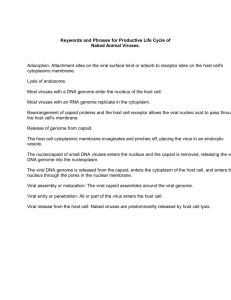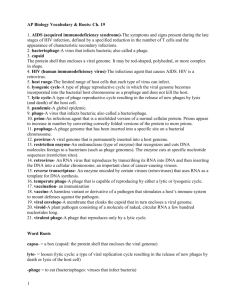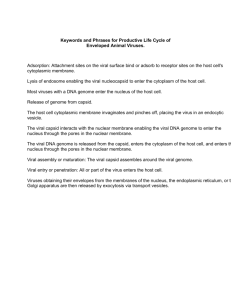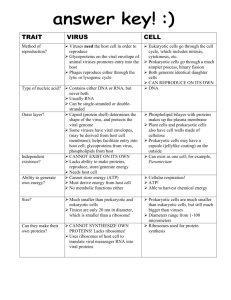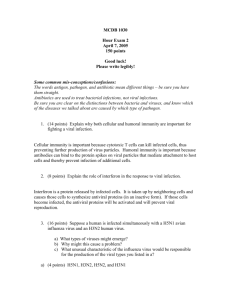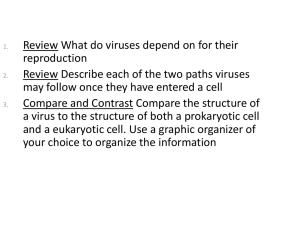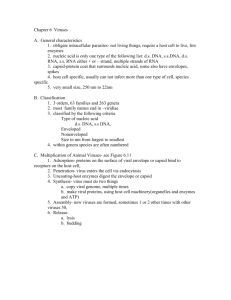Chapter 19: Viruses - Biology E
advertisement
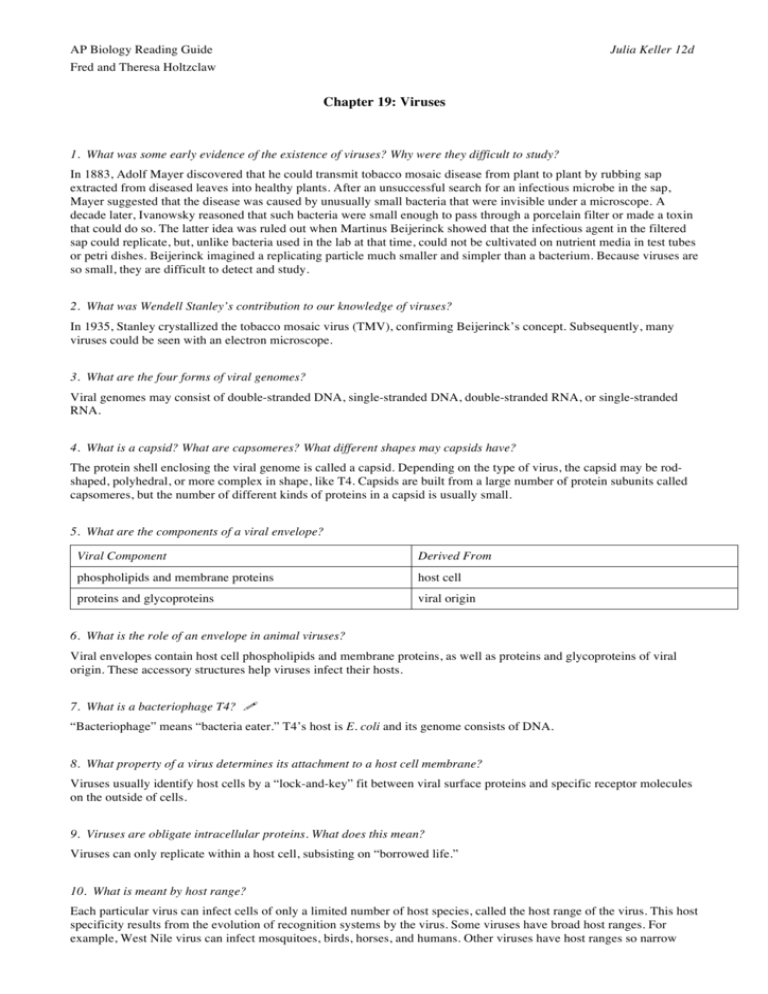
AP Biology Reading Guide Fred and Theresa Holtzclaw Julia Keller 12d Chapter 19: Viruses 1. What was some early evidence of the existence of viruses? Why were they difficult to study? In 1883, Adolf Mayer discovered that he could transmit tobacco mosaic disease from plant to plant by rubbing sap extracted from diseased leaves into healthy plants. After an unsuccessful search for an infectious microbe in the sap, Mayer suggested that the disease was caused by unusually small bacteria that were invisible under a microscope. A decade later, Ivanowsky reasoned that such bacteria were small enough to pass through a porcelain filter or made a toxin that could do so. The latter idea was ruled out when Martinus Beijerinck showed that the infectious agent in the filtered sap could replicate, but, unlike bacteria used in the lab at that time, could not be cultivated on nutrient media in test tubes or petri dishes. Beijerinck imagined a replicating particle much smaller and simpler than a bacterium. Because viruses are so small, they are difficult to detect and study. 2. What was Wendell Stanley’s contribution to our knowledge of viruses? In 1935, Stanley crystallized the tobacco mosaic virus (TMV), confirming Beijerinck’s concept. Subsequently, many viruses could be seen with an electron microscope. 3. What are the four forms of viral genomes? Viral genomes may consist of double-stranded DNA, single-stranded DNA, double-stranded RNA, or single-stranded RNA. 4. What is a capsid? What are capsomeres? What different shapes may capsids have? The protein shell enclosing the viral genome is called a capsid. Depending on the type of virus, the capsid may be rodshaped, polyhedral, or more complex in shape, like T4. Capsids are built from a large number of protein subunits called capsomeres, but the number of different kinds of proteins in a capsid is usually small. 5. What are the components of a viral envelope? Viral Component Derived From phospholipids and membrane proteins host cell proteins and glycoproteins viral origin 6. What is the role of an envelope in animal viruses? Viral envelopes contain host cell phospholipids and membrane proteins, as well as proteins and glycoproteins of viral origin. These accessory structures help viruses infect their hosts. 7. What is a bacteriophage T4? ! “Bacteriophage” means “bacteria eater.” T4’s host is E. coli and its genome consists of DNA. 8. What property of a virus determines its attachment to a host cell membrane? Viruses usually identify host cells by a “lock-and-key” fit between viral surface proteins and specific receptor molecules on the outside of cells. 9. Viruses are obligate intracellular proteins. What does this mean? Viruses can only replicate within a host cell, subsisting on “borrowed life.” 10. What is meant by host range? Each particular virus can infect cells of only a limited number of host species, called the host range of the virus. This host specificity results from the evolution of recognition systems by the virus. Some viruses have broad host ranges. For example, West Nile virus can infect mosquitoes, birds, horses, and humans. Other viruses have host ranges so narrow that they infect only a single species. Measles virus, for instance, can only infect humans. Viral infection of multicellular eukaryotes is usually limited to particular tissues. 12. Compare the host range for the rabies virus to that of the human cold virus. While human cold viruses infect only the cells lining the upper respiratory tract, rabies virus can infect most mammal species. 12. What components of the host cell does a virus use to reproduce itself? The host provides the nucleotides for making viral nucleic acids, as well as enzymes, ribosomes, tRNAs, amino acids, ATP, and other components needed for making the viral proteins. 13. How does a DNA virus reproduce its genome? Many DNA viruses use the DNA polymerases of the host cell to synthesize new genomes along the templates provided by the viral DNA. 14. How do most RNA viruses replicate their genome? To replicate their genomes, RNA viruses use virally encoded RNA polymerases that can use RNA as a template. 15. Explain the viral reproductive cycle. ! First, a virus enters the cell and is uncoated, releasing viral DNA and capsid proteins. Next, host enzymes replicate the viral genome. Meanwhile, host enzymes transcribe the viral genome into viral mRNA, which host ribosomes use to make more capsid proteins. Finally, viral genomes and capsid proteins self-assemble into new virus particles, which exit the cell. 16. What are bacteriophages? A bacteriophage is a virus that infects bacteria. A phage replicative cycle that culminates in death of the host cell is known as a lytic cycle. A phage that replicates only by the lytic cycle is a virulent phage. In contrast to the lytic cycle, which kills the host cell, the lysogenic cycle allows replication of the phage genome without destroying the host. Phages capable of using both modes of replicating within a bacterium are called temperate phages. 17. What portion of a phage enters the host cell? How does it do this? After the bacteriophage binds to a specific receptor on the outer surface of the host cell, the sheath of the tail contracts, injecting the phage DNA into the cell and leaving an empty capsid outside. The cell’s DNA is hydrolyzed. 18. What are restriction enzymes? What is their role in bacteria? Restriction enzymes restrict the ability of the phage to infect a bacterium. 19. Why don’t restriction enzymes destroy the DNA of the bacterial cells that produce them? The bacterial cell’s own DNA is methylated in a way that prevents attack by its own restriction enzymes. 20. What are three ways bacteria may win the battle against the phages? Just as natural selection favors bacteria with mutant receptors or effective restriction enzymes, it also favors phage mutants that can bind the altered receptors or are resistant to particular restriction enzymes. Thus, the parasite-host relationship is in constant evolutionary flux. Moreover, instead of lysing their host cells, many phages coexist with them in a state called lysogeny. 21. What is a prophage? When integrated into a specific site on a bacterial chromosome, viral DNA is known as a prophage. 22. What might trigger the switchover from lysogenic to lytic mode? An environmental signal, such as a certain chemical or high-energy radiation, usually triggers the switchover from the lysogenic to the lytic mode. 24. Describe the lytic and lysogenic modes of bacteriophage reproduction. The lytic mode of bacteriophage reproduction results in the release of new phages through the lysis of the host cell. The lysogenic mode allows the viral genome to be replicated along with the bacterial chromosome in the form of a prophage without killing the host. 25. What two elements do nearly all animal viruses have? Nearly all animal viruses have a membranous envelope and an RNA genome. 26. What is a retrovirus? How do retroviruses, such as HIV, replicate their genome? Retroviruses have the most complicated replicative cycles. Equipped with an enzyme called reverse transcriptase, these viruses transcribe an RNA template into DNA, providing an RNA to DNA information flow. The integrated viral DNA, called a provirus, never leaves the host’s genome, remaining a permanent resident of the cell. The host’s RNA polymerase transcribes the proviral DNA into RNA molecules, which can function both as mRNA for the synthesis of viral proteins and as genomes for the new viruses that will be assembled and released from the cell. 28. Compare and contrast a prophage and a provirus. Which one are you likely to carry? A prophage is a phage genome inserted into a specific site on a bacterial chromosome. A provirus is a viral genome permanently inserted into a host genome. Animal cells would most likely carry a provirus. 29. Explain the infection of a cell by HIV. ! Its envelope glycoproteins enable HIV to bind to specific receptors on certain white blood cells. The virus fuses with the cell’s plasma membrane. The capsid proteins are removed, releasing the viral proteins and RNA. Reverse transcriptase catalyzes the synthesis of a DNA strand complementary to the viral RNA. Reverse transcriptase catalyzes the synthesis of a second DNA strand complementary to the first. The double-stranded DNA is incorporated as a provirus into the cell’s DNA. Proviral genes are transcribed into RNA molecules, which serve as genomes for the next viral generation and as mRNAs for translation into viral protein. The viral proteins include capsid proteins, reverse transcriptase and envelope glycoproteins. Vesicles transport the glycoproteins to the cell’s plasma membrane. Capsids are assembled around viral genomes and reverse transcriptase molecules. New viruses bud off from the host cell. 30. Describe the two possible sources of viral genomes. Mobile genetic element Description plasmid small, circular DNA molecule found in bacteria and unicellular eukaryotes (yeasts) transposon DNA segment that can move from one location to another within a cell’s genome

